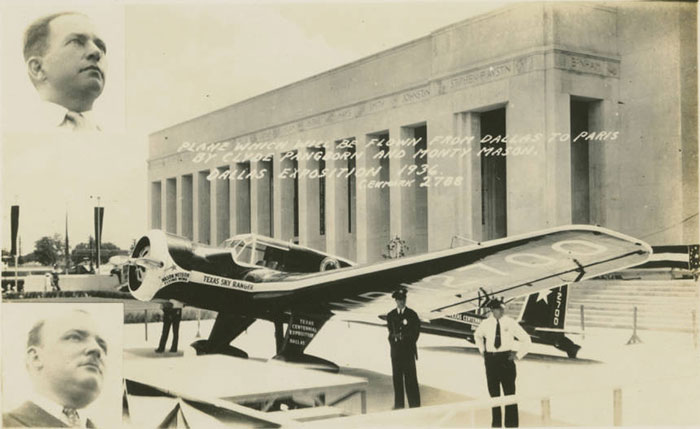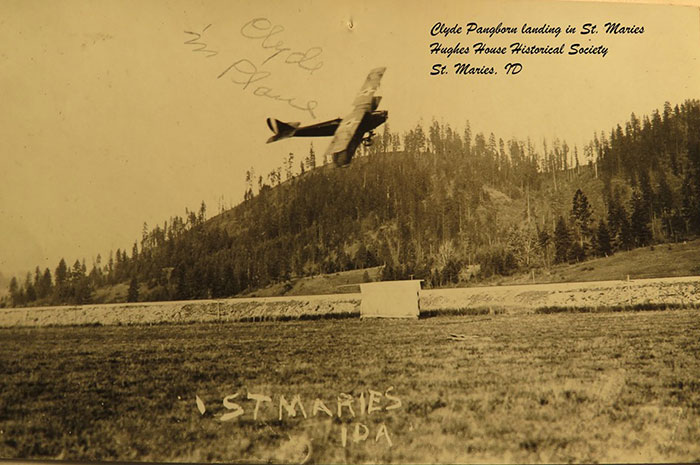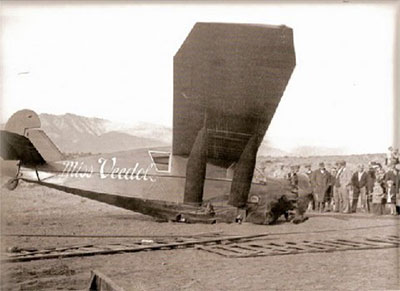THANK YOU!
YOUR PURCHASE OF THESE BOOKS SUPPORTS THE WEB SITES THAT BRING TO YOU THE HISTORY BEHIND OLD AIRFIELD REGISTERS
Your copy of the Davis-Monthan Airfield Register 1925-1936 with all the pilots' signatures and helpful cross-references to pilots and their aircraft is available at the link. 375 pages with black & white photographs and extensive tables
---o0o---
The Congress of Ghosts (available as eBook) is an anniversary celebration for 2010. It is an historical biography, that celebrates the 5th year online of www.dmairfield.org and the 10th year of effort on the project dedicated to analyze and exhibit the history embodied in the Register of the Davis-Monthan Airfield, Tucson, AZ. This book includes over thirty people, aircraft and events that swirled through Tucson between 1925 and 1936. It includes across 277 pages previously unpublished photographs and texts, and facsimiles of personal letters, diaries and military orders. Order your copy at the link.
---o0o---
Military Aircraft of the Davis Monthan Register 1925-1936 is available at the link. This book describes and illustrates with black & white photographs the majority of military aircraft that landed at the Davis-Monthan Airfield between 1925 and 1936. The book includes biographies of some of the pilots who flew the aircraft to Tucson as well as extensive listings of all the pilots and airplanes. Use this FORM to order a copy signed by the author, while supplies last.
---o0o---
Art Goebel's Own Story by Art Goebel (edited by G.W. Hyatt) is written in language that expands for us his life as a Golden Age aviation entrepreneur, who used his aviation exploits to build a business around his passion. Available as a free download at the link.
---o0o---
Winners' Viewpoints: The Great 1927 Trans-Pacific Dole Race (available as eBook) is available at the link. This book describes and illustrates with black & white photographs the majority of military aircraft that landed at the Davis-Monthan Airfield between 1925 and 1936. The book includes biographies of some of the pilots who flew the aircraft to Tucson as well as extensive listings of all the pilots and airplanes. Use this FORM to order a copy signed by the author, while supplies last.
---o0o---
Clover Field: The first Century of Aviation in the Golden State (available in paperback) With the 100th anniversary in 2017 of the use of Clover Field as a place to land aircraft in Santa Monica, this book celebrates that use by exploring some of the people and aircraft that made the airport great. 281 pages, black & white photographs.
---o0o---
YOU CAN HELP
I'm looking for information and photographs of Pangborn and his airplane to include on this page. If you have some you'd like to share, please click this FORM to contact me.
---o0o---
SPONSORED LINKS
HELP KEEP THESE WEB SITES ONLINE
FOR YOUR CONVENIENCE
You may NOW donate via PAYPAL by clicking the "Donate" icon below and using your credit card. You may use your card or your PAYPAL account. You are not required to have a PAYPAL account to donate.
When your donation clears the PAYPAL system, a certified receipt from Delta Mike Airfield, Inc. will be emailed to you for your tax purposes.
---o0o---
CLYDE EDWARD PANGBORN
Clyde Pangborn landed twice at Peterson Field. His first visit was between August 13th and August 16, 1934 (he didn't write a date in the Register). He carried two passengers and a crew of one, all unidentified. They flew the Lockheed Air Express he identified as NC3057. The airplane belonged to Roscoe Turner. Pangborn and passengers arrived from Omaha, NB and they were headed for Denver, CO.
About three years earlier, Pangborn, with financial support from his copilot Hugh Herndon, Jr., flew the first plane (a Bellanca Skyrocket named “Miss Veedol”) across the Pacific Ocean nonstop from Japan to Washington State. They arrived in the U.S. October 3, 1931. Details of that flight are at Herndon's link, as well as a photograph of Pangborn and Herndon with an injury over his right eye acquired during the landing in Washington.
A pertinent anecdote regarding the arrival of "Miss Veedol" back in the U.S. is below. The text and photograph are courtesy of Pangborn's cousin, Jack Roberts.
"I can identify the date and place of the photo of Herndon that shows the blood below his eye. This was taken moments after he egressed the airplane (out of a window like the one you see below but on the other side) after the landing at Fancher Field on the plateau above the Columbia River in what is now East Wenatchee about 7:00AM October 5, 1931.
"Pangborn had dumped the remaining 100 gallons of fuel and had sent Herndon to the back of the Bellanca for weight in the rear for the dead stick belly landing. The plane went up on it's nose, paused there for a moment and fell back on it's belly and left wing. That was the only injury from the landing. "Herndon was a socialite with money. Pangborn's contract was to provide aviation skills and Herndon provided $100,000.00 for the trip. Herndon was to go to navigation school but went on a honeymoon instead. When they got over the Atlantic, Herndon confessed and Pang did all the flying except for about ten hours and all the navigating for the entire round the world flight. "Pang was forbidden by contract to publicize or exploit his part of the flight till Herndon recovered his $100K and since Herndon had no real part in the flight except to occupy space and almost get them killed when he failed to manage fuel distribution in the five fuel tanks and the engine quit over the North Pacific, he kept Pangborn out of the history books. That's why Pang doesn't appear anywhere of note." |
Pangborn's second landing at Colorado Springs was about a year later on Wednesday, September 18, 1935 at 3:45PM. He flew a Bellanca he clearly identified as NC1029. Interestingly, NC1029 is listed as an Alexander Eaglerock in a database of vintage aircraft. Regardless, he carried a crew of two and a single unidentified passenger. They were enroute from Denver, CO to Albuquerque, NM. Pangborn identified his home base as Flushing, NY.
Below is a publicity photograph from the Southern Methodist University Cook Dallas/Texas Image Collection. It shows Pangborn, top, and Monte Mason poised for what was planned to be a flight from Dallas, TX to Paris, France in 1936.The airplane is a Vance Viking designed by Register Pilot Claire Vance, and built ca. 1932. Vance died December 18, 1932 in an airplane crash near Oakland, CA. His airplane, NC12700, was entered in the 1933 and 1934 Bendix Races, but never competed. The airplane was sold by his wife after his death. It made its way to Mason, who named it the Mason Meteor Flying Wing. The trans-Atlantic flight was planned in celebration of the Texas Centennial Exposition. This is odd, since Texas acquired statehood in December 29, 1845. To my knowledge, this flight was never made.
 |
Pangborn has a good Web presence. A quality biography is at the National Aviation Hall of Fame Web site at the link. He wrote an article entitled, "I Learned About Flying From That," which appeared in Popular Aviation, July, 1939. The article is available for download at the link (PDF 1.2Mb). It is a harrowing account of a accelerated stall into a spin, which Pangborn managed to exit lower to the ground than he wanted. Note the photograph of Roscoe Turner posed with Pangborn in the article.
The Aviation Hall of Fame site states, "In 1919 Pangborn was an instructor at Ellington Field in Texas when the base commander offered him and his friend Lt. Ralph Reid their own plane while at the field. All they had to do was patch and repair the old Jenny. Since straightaway flying is dull, the two thought up tricks to perform, such as diving on barnyards to watch horses jump over fences and cows kick over milk pails. They tried to take the knob from the community flagpole and the hands from the town hall clock. To keep from being caught, Pangborn and Reid used washable paint to disguise the plane’s numbers, changing them from 314 to 841, 341 or 344." Bob Woodling found the following two photographs from a Pangborn family album online that capture Pangborn and Reid in St. Maries, Idaho during this phase. The first shows Pangborn and Reid standing in front of their Jenny.
 |
There appears to be a rail trestle behind them. The next image show their aircraft aloft in a steep turn.
 |
The Manuscripts, Archives, and Special Collections of the Washington State University holds an archive of Pangborn's documents, business records and photographs, described at the link. The link also has an excellent biographical summary.
Pangborn flew with Transport pilot certificate T240, meaning he was the 240th licensed transport pilot in the U.S., a very low number. He was born in Bridgeport, WA October 28, 1894. He flew West from New York City at age 63, on March 29th, 1958, and was buried at Arlington National Cemetery with military honors.
---o0o---
SPONSORED LINKS
THIS PAGE UPLOADED: 03/21/14 REVISED: 07/17/14, 05/31/19, 10/06/19

